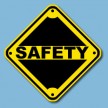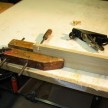Tips For Using A Drill Press
Using A Drill Press
Tips for using a drill press include matching the speed of the drill to the bit being used and matching the drill bit to the material being drilled.
- Drill press speed depend on lots of things:
- the type of material being drilled and its hardness
- the hole size
- the type
- hardness of the drill bit
- its sharpness
- whether or not a cutting or cooling fluid is used
- the rigidity of the drill and clamp
Tips For Using A Drill Press:
1. Use oil when drilling metal to help cool the bit and lubricate.
2. Clamp the piece securely down.
3. Change speeds for different drill bits and drill to the right depth.
Guide for drill press speeds:
- Wood: 3000 for thinner bits and down to 750 for larger bits
- Steel: spindle speed between 700-1000 rpms.
- Aluminum: above 2000 rpms.
Below is a picture of my drill press. The speeds are changed by moving the belt on the pulleys. A chart affixed to the drill motor indicates the speeds of each pulley.
See WOOD magazines drill speed chart.
Bottom line: “Going slower usually doesn’t hurt, and will prolong tool life. “
See Smoke? Slow down
If the chips are smoking, turning brown, or the outer edge of the drill bit is chipping, go slower or add some cutting oil / coolant.
In general, a slower-than-recommended spindle speed won’t hurt anything except in the case of extremely small drill bits, say smaller than 1/16″. With small bits, it’s hard to feel resistance from the metal, and therefore, very easy to push down faster than they can remove metal.



























